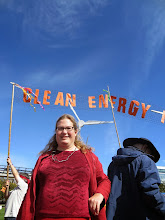Last year, the big solar companies started coming here Colorado’s San Luis Valley – Tessera Solar proposing 1,500 acres of noisy 40-foot tall engines, and Solar Reserve proposing a 650-foot tower directly west of Great Sand Dunes National Park.
Citizens in Colorado’s San Luis Valley are planning a better alternative – a network of arrays from rooftop size up to the scale of the 8 Megawatt facility currently in operation near Mosca. The total size of our planned project is similar – about 150 Megawatts, or 25 Megawatts in each of the Valley’s six counties. We propose using batteries to buffer short term fluctuations, pumped hydroelectric storage for power on demand, and geothermal energy for backup power at night and on cloudy days.
There is only so much room on existing transmission lines to export power – we shouldn’t let Tessera hog this capacity!
Why is distributed solar better than a centralized solar plant?
1. More jobs are created per dollar spent
A distributed project will constantly have arrays in the pipeline, so workers will have more consistent work than the current “boom and bust”. Based on data from the Colorado Solar Energy Industry Association, we estimate our project will generate approximately 300 direct jobs for a period of five years, with up to 1,000 jobs total given the multiplier effect.
2. Communities will own the arrays
Tax motivated investors have an incentive to donate the facilities to non profits, schools, or municipalities. The facilities will be managed by a trust, in cooperation with local charities, for maximum community benefit.
3. It’s more cost-effective
Concentrated Solar Power plants used to cost less per watt produced than ordinary PV panels. Now, the cost is approximately equal, with the cost of solar panels expected to drop still further, out-competing other technologies. The high cost of maintaining Suncatchers would leave us with a giant white elephant while the rest of the state modernizes.
4. Impacts are less concentrated
Rather than siting facilities on productive land, we are placing them on the corners of farm fields, on dumps and old mines, and the places where nothing will grow. Smaller arrays give us a much wider choice of possible sites, and communities choose where they will go.
5. Power production is more consistent
A point source of solar such as Tessera would flip on and off on our frequent days of patchy clouds. Spreading a solar plant around the valley in smaller units will buffer this variability, since some arrays will receive sunshine while others are shaded.
Solar arrays have fewer moving parts than experimental technologies like solar Stirling engines or power towers. The turbines in coal and gas power plants shut down for scheduled and unscheduled maintenance, while regular solar panels are just so darn reliable!
6. Silicon solar panels work better here
Many different solar technologies are being proposed, but the fact remains that good ol’ Silicon solar panels work better in our cool sunshine than just about anywhere else.
7. Benefits to local businesses
The San Luis Valley can be at the forefront of distributed agricultural and small town solar. New startup companies are forming, local solar companies will get more work, and money staying in the area will multiply the positive effects.
8. Less need for transmission lines
Rather than overbuilding in the SLV, we can expand the project to other parts of the state, and other states. By putting solar energy closer to the people who use the energy, there’s less need to build expensive new transmission.
9. Our viewscape and soundscape are preserved, and less water is needed
Ordinary solar panels are low to the ground, don’t use water, and don’t make any noise. No 650-foot towers or fields of 40-foot mirrors are required.
10. It’s something we can all agree on
The Tessera and Solar Reserve projects are facing opposition which will likely continue through the approval process and the courts, and might be delayed for years. Distributed projects have a streamlined approval process and are much less controversial. Why be divided when there is something we can all get behind?
Are you interested in being a part of this project? Just email info@solargardens.org and we can add your site to the list. We already have more acres than the Tessera proposal, in parcels around Colorado!
Sincerely,
Joy Hughes
Solar Gardens Institute
Subscribe to:
Post Comments (Atom)


No comments:
Post a Comment